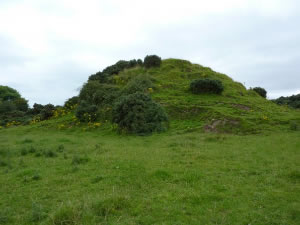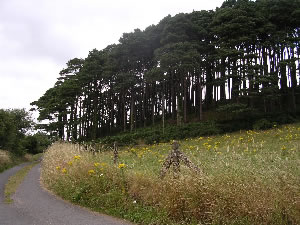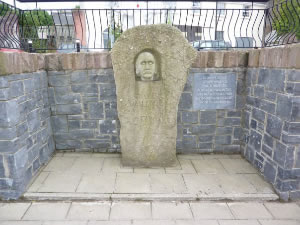|
|
|
The Moat, Barrack St.
 The moat is an exceptionally fine example of a platform ring fort, it is about thirty-four feet high and is surrounded by three concentric banks and fosses. It may have been a ceremonial mound of some kind, perhaps the inauguration place of long-forgotten rulers who once held sway over this territory.
The moat is an exceptionally fine example of a platform ring fort, it is about thirty-four feet high and is surrounded by three concentric banks and fosses. It may have been a ceremonial mound of some kind, perhaps the inauguration place of long-forgotten rulers who once held sway over this territory.
Ballyriggan Woods, Ballyriggan
 Ballyriggan Wood is a well known landmark on Palentine Hill approximately 1 kilometre east of Kilfinane town. It is associated with the local Palentine Settlement who planted the trees in 1831. The plantation consists of Scots Pine, European Larch and Sycamore.
Ballyriggan Wood is a well known landmark on Palentine Hill approximately 1 kilometre east of Kilfinane town. It is associated with the local Palentine Settlement who planted the trees in 1831. The plantation consists of Scots Pine, European Larch and Sycamore.
Staker Wallace Monument, The Square
The Square  Staker Wallace (Patrick) was the leader of his local company of United Irishmen and in 1798 Captain Charles Oliver ordered his troops to capture Wallace and charge him with planning his murder. Once captive Oliver bribed, tortured and flogged Wallace to give information regarding his fellow Irishmen but loyal Wallace refused to inform on his friends and was later hanged and beheaded. His head was set on a spike above the market house in the Square. His heroism and tragic fate made such an impact on the local people that his memory lives on today.
Staker Wallace (Patrick) was the leader of his local company of United Irishmen and in 1798 Captain Charles Oliver ordered his troops to capture Wallace and charge him with planning his murder. Once captive Oliver bribed, tortured and flogged Wallace to give information regarding his fellow Irishmen but loyal Wallace refused to inform on his friends and was later hanged and beheaded. His head was set on a spike above the market house in the Square. His heroism and tragic fate made such an impact on the local people that his memory lives on today.
The Old Corn Mill, Mill Hill

 Kilfinane was formely a busy market town, it also had a thriving flour mill and was the centre of an area in which flax was extensively grown and in which spinning was carried out in many homes.
Kilfinane was formely a busy market town, it also had a thriving flour mill and was the centre of an area in which flax was extensively grown and in which spinning was carried out in many homes.
Cill Fhionáin, the Church of St Finnian, The Catholic Church is a fine late-eighteenth-century sandstone building. There are two shrines in the parish. The Marian Shrine was erected in the Marian Year of 1954. This shrine is located at Mill Hill.
The statue to the Sacred Heart is in the Main Street in Kilfinane.
St Finnian resided in a small hut beside the River Lubagh at the time of St Patrick's conversion of Ireland. His hut was located close to Tobernane, a little spring. The area was known as Fobar Fionán. St Finnian led a monastic life in this area, praying and meditating daily. Residents in the nearby village became curious as to the purpose of his visit to the area. They observed his actions, and heard his prayers and psalms. Eventually they became converted to his way of thinking. When St Finnian left the area, the local people built a house of worship in his honour, and named it Cill Finnian, the church of Finnian. With the passing of time the surrounding area became known as Kilfinane
by John O'Donnell
(local Poet)
One dusky evening out I strode
I met a fairy on the road
He asked me if I slowed my pace
Some stories to me he would trace
Then wittily to me did quote
His home was once Kilfinane moat
Though fraught 'twould be that I should fail
To hear this little fellow's tale
Then bade me to sit down awhile
Beside him on the little stile
Observed were we by Clancy's goat
That grazed beside Kilfinane moat
My age is many years says he
One thousand, two or maybe three
Since ancient kings of Munster stood
Here in “Druimfingin of the Wood”
Where all those kings upon my oath
Were crowned upon Kilfinane moat
From my fairy nook I watched their feasts
And hold their court with pagan priests
While witches worked their sorcery
On the summit high on Troid na Rí
And with my cap and crimson coat
I danced around Kilfinane moat
From Troid na Rí the glory fled
Now hushed and quiet as Oscars bed
No festive fires send tongues of light
To break the darkness of the night
There's now just Clancy's cows and goat
To graze around Kilfinane moat
Here strapping youth inscribed their names
On Sráid na Faicha's ancient games
Those giants of lads were oft times seen
To jump across Glenmamaheen
Those ancient passtimes now remote
I witnessed from Kilfinane moat
My tales are thrice a thousand years
As old Methussela or his peers
While there behind us my old home
As old as Greece or Ancient Rome
Where Erins legions on my oath
In squadroms passed Kilfinane moat
The minstrel sang a tuneful praise
To crowds attending aonach days
The bugels fanfare loud would thrill
My cousins on Knocksouna Hill
While warhorse proud or humble goat
Were bartered by Kilfinane moat
An archaeologist one time tried
To see what he might find inside
Employed some diggers for his chores
Who soon broke out in scabs and sores
And ne'er again they swore on oath
Would tamper with Kilfinane moat
The brogues I wear came from a coomb
Of fairy cobblers in Macroom
And for a hammer they did swap
A shuttle for our sewing shop
So I weaved my hat and crimson coat
From my loom inside Kilfinane moat
The night soon passed, 'twas breaking dawn
As both of us began to yawn
But fraught 'twould be if I did fail
To hear this little fellow's tale
We bade adieu to Clancy's goat
That grazed around Kilfinane moat